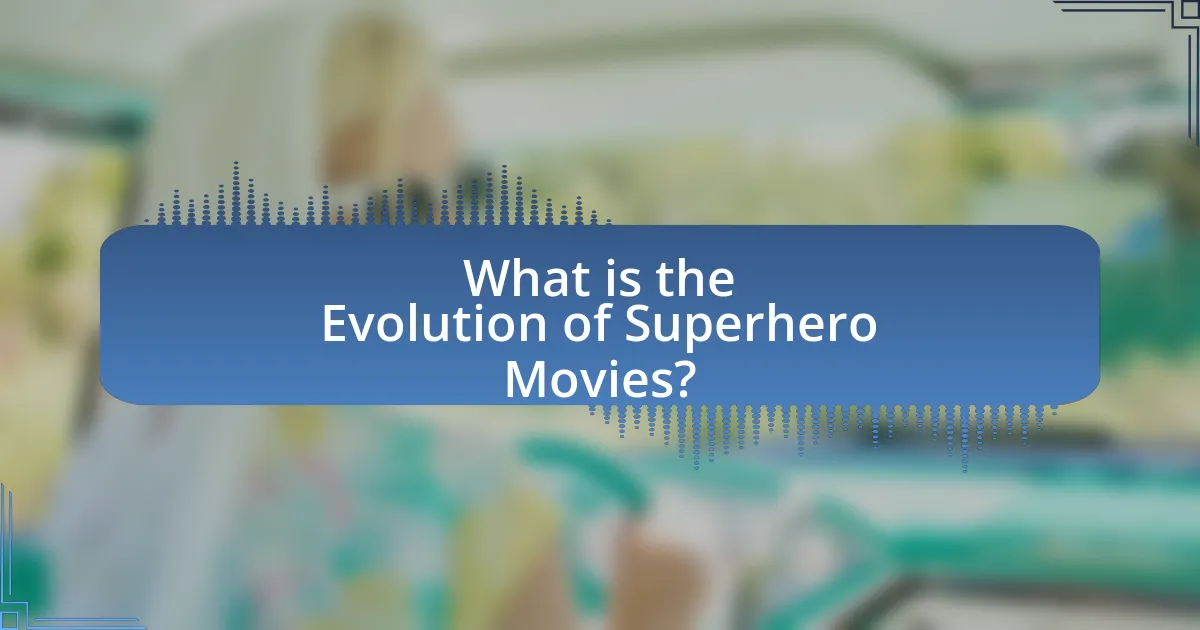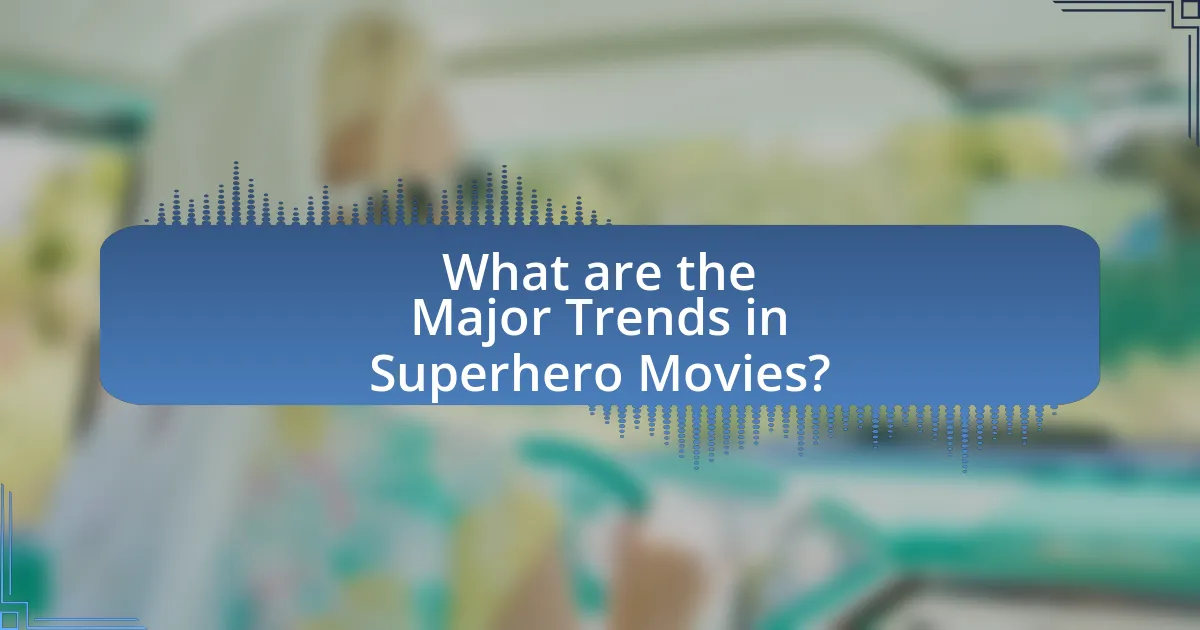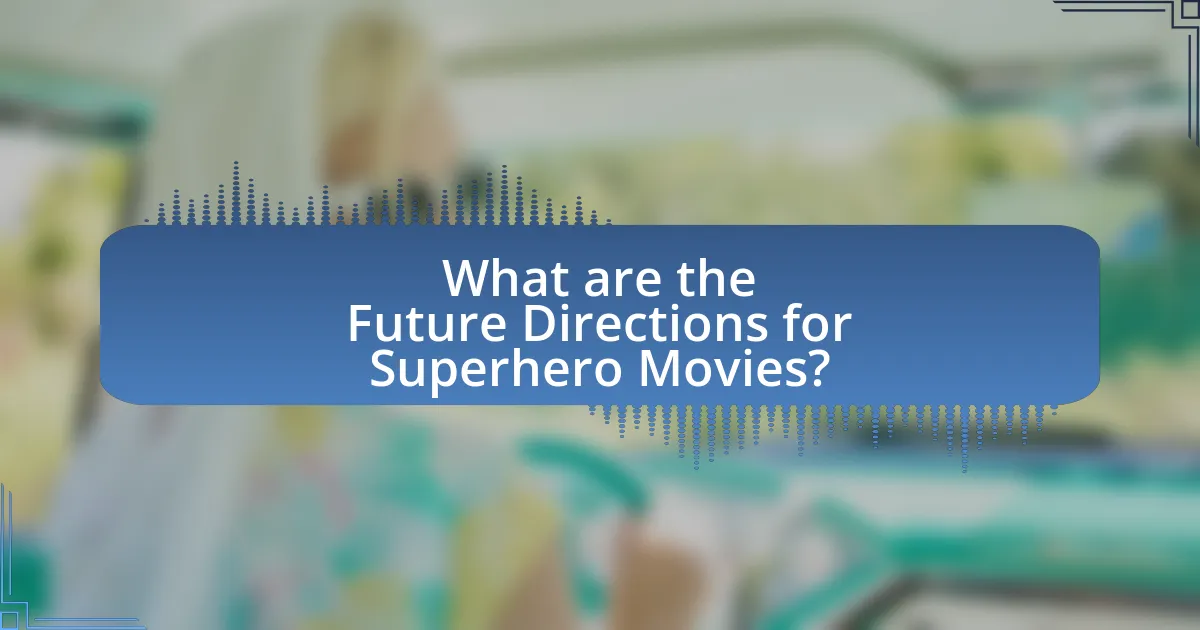The article examines the evolution of superhero movies, tracing their development from the campy classics of the 1930s and 1960s to the darker, more complex narratives of modern cinema. It highlights key milestones, such as the impact of “Superman: The Movie” and the transformative influence of the Marvel Cinematic Universe, which introduced interconnected storytelling. The article also discusses how societal attitudes, technological advancements, and audience expectations have shaped the genre, emphasizing the significance of character complexity and diverse representation in contemporary superhero films. Additionally, it explores future directions for the genre, including the integration of diverse narratives and the exploration of moral themes.

What is the Evolution of Superhero Movies?
The evolution of superhero movies began in the 1930s with the release of serials like “The Adventures of Captain Marvel,” which laid the groundwork for future adaptations. In the 1960s, the campy “Batman” television series popularized the genre, leading to the 1966 film that embraced a humorous tone. The 1978 release of “Superman: The Movie” marked a significant turning point, introducing a more serious and cinematic approach to superhero storytelling, which was further developed in the 1980s and 1990s with films like “Batman” (1989) and “Blade” (1998), showcasing darker themes and complex characters. The early 2000s saw the rise of the modern superhero era with the release of “X-Men” (2000) and “Spider-Man” (2002), which combined character depth with blockbuster appeal. The Marvel Cinematic Universe, starting with “Iron Man” in 2008, revolutionized the genre by creating an interconnected universe, leading to unprecedented box office success and critical acclaim. This evolution reflects a shift from campy and simplistic narratives to darker, more nuanced storytelling that resonates with contemporary audiences.
How did superhero movies begin and what were their early influences?
Superhero movies began in the early 20th century, with the first notable film being “The Mark of Zorro” in 1920, which featured a masked vigilante. Early influences included comic strips and pulp magazines, particularly the popularity of characters like Superman, who debuted in Action Comics #1 in 1938, leading to a surge in superhero-themed films during the 1940s. The 1941 film “Captain America” and the 1943 serial “Batman” were among the first adaptations that showcased the genre’s potential. These films drew inspiration from the heroic narratives found in literature and the growing comic book industry, which provided a rich source of characters and stories that resonated with audiences.
What characteristics defined the campy classics of the superhero genre?
Campy classics of the superhero genre are characterized by their exaggerated performances, colorful costumes, and humorous, often self-referential dialogue. These films, such as the 1960s “Batman” television series and “Superman: The Movie,” embraced a playful tone that contrasted sharply with the darker themes of later superhero narratives. The use of vibrant visuals and over-the-top action sequences further emphasized their lighthearted approach, appealing to both children and adults. This style was a deliberate choice to entertain and engage audiences, making the genre accessible and enjoyable during its peak in the mid-20th century.
How did societal attitudes shape the portrayal of superheroes in early films?
Societal attitudes significantly influenced the portrayal of superheroes in early films by reflecting the cultural values and concerns of the time. During the 1930s and 1940s, superheroes often embodied ideals of justice, heroism, and patriotism, mirroring the public’s desire for hope and stability during the Great Depression and World War II. For instance, characters like Superman, introduced in 1938, represented the American ideal of strength and moral integrity, appealing to audiences seeking reassurance in turbulent times. Additionally, the portrayal of superheroes often aligned with prevailing gender norms, as male heroes dominated the screen while female characters were frequently relegated to supporting roles, reflecting the societal expectations of masculinity and femininity during that era. This alignment of superhero narratives with societal attitudes helped solidify their popularity and cultural significance in early cinema.
What key milestones marked the transition from campy classics to darker themes?
The key milestones marking the transition from campy classics to darker themes in superhero movies include the release of “Batman” in 1989, which introduced a more serious tone, and “The Dark Knight” in 2008, which further established the darker, more complex narratives. “Batman” directed by Tim Burton shifted the genre’s perception by incorporating gothic elements and a more nuanced portrayal of its characters, moving away from the lightheartedness of earlier films like the 1966 “Batman.” “The Dark Knight,” directed by Christopher Nolan, is often cited as a pivotal moment due to its exploration of moral ambiguity and psychological depth, particularly through the character of the Joker, which resonated with audiences and critics alike, solidifying the darker approach as a new standard in superhero storytelling.
Which films are considered pivotal in this evolution?
The films considered pivotal in the evolution of superhero movies include “Batman” (1989), “Spider-Man” (2002), and “The Dark Knight” (2008). “Batman,” directed by Tim Burton, marked a shift towards a darker and more serious tone in superhero films, setting the stage for future adaptations. “Spider-Man,” directed by Sam Raimi, popularized the modern superhero genre and established a successful formula for character-driven storytelling. “The Dark Knight,” directed by Christopher Nolan, further transformed the genre by introducing complex themes and moral ambiguity, earning critical acclaim and commercial success, which influenced subsequent films in the genre.
How did the success of comic book adaptations influence the genre?
The success of comic book adaptations significantly influenced the genre by establishing a profitable and popular framework for storytelling in film. This success, exemplified by box office hits like “Spider-Man” (2002) and “The Dark Knight” (2008), demonstrated that superhero narratives could attract large audiences and generate substantial revenue, leading studios to invest heavily in similar projects. As a result, the genre evolved from campy portrayals to more complex and darker themes, reflecting societal issues and character depth, as seen in films like “Logan” (2017) and “Black Panther” (2018). This shift not only broadened the appeal of superhero films but also set new standards for production quality and narrative sophistication within the genre.
Why is the shift to dark realism significant in modern superhero films?
The shift to dark realism is significant in modern superhero films because it reflects a deeper exploration of complex themes such as morality, trauma, and societal issues. This approach allows filmmakers to create narratives that resonate with contemporary audiences, as seen in films like “The Dark Knight,” which addresses themes of chaos and ethics in a post-9/11 context. The success of these films, both critically and commercially, demonstrates that audiences are drawn to more nuanced storytelling that challenges traditional notions of heroism and villainy. This evolution in tone has led to a broader acceptance of superhero films as a legitimate genre capable of addressing serious subject matter, thereby expanding their cultural impact.
What themes are prevalent in dark realism superhero movies?
Prevalent themes in dark realism superhero movies include moral ambiguity, psychological trauma, and societal critique. These films often explore the complexities of heroism, where characters grapple with ethical dilemmas and the consequences of their actions, reflecting a more nuanced view of good and evil. For instance, movies like “The Dark Knight” showcase the psychological struggles of characters like Batman and the Joker, emphasizing the impact of trauma on their identities. Additionally, dark realism often critiques societal issues, such as corruption and injustice, as seen in “Watchmen,” which questions the morality of vigilante justice in a flawed society.
How do character complexities contribute to the darker narratives?
Character complexities enhance darker narratives by providing depth and moral ambiguity, which reflect the complexities of real human experiences. In superhero movies, characters like Batman and Wolverine embody internal struggles, grappling with trauma, ethical dilemmas, and personal flaws. This complexity allows audiences to engage with their journeys on a deeper emotional level, making the narratives more relatable and impactful. For instance, Christopher Nolan’s “The Dark Knight” showcases the psychological conflict within characters, particularly the Joker’s chaotic philosophy against Batman’s moral code, illustrating how these complexities drive the story’s tension and darkness. Such character-driven narratives challenge traditional notions of heroism and villainy, ultimately enriching the storytelling experience.

What are the Major Trends in Superhero Movies?
Major trends in superhero movies include the rise of interconnected cinematic universes, a focus on diverse representation, and the exploration of darker, more complex narratives. The interconnected cinematic universe trend began with Marvel’s “Iron Man” in 2008, leading to a series of films that share characters and storylines, significantly boosting box office revenues and audience engagement. Additionally, the push for diverse representation has gained momentum, with films like “Black Panther” and “Wonder Woman” showcasing underrepresented heroes and stories, reflecting broader societal changes. Furthermore, the trend towards darker narratives is exemplified by films such as “The Dark Knight” and “Logan,” which delve into moral ambiguity and character depth, appealing to a more mature audience. These trends collectively illustrate the evolving landscape of superhero cinema, adapting to audience expectations and cultural shifts.
How have audience expectations changed over time?
Audience expectations for superhero movies have evolved significantly from the campy, lighthearted narratives of the 1960s and 1970s to the darker, more complex storytelling seen in contemporary films. Initially, audiences sought simple, entertaining escapism, as exemplified by the 1966 “Batman” television series, which featured campy humor and colorful characters. Over time, particularly after the release of “The Dark Knight” in 2008, viewers began to demand deeper character development, moral ambiguity, and realistic themes, reflecting societal issues and personal struggles. This shift is evidenced by the critical and commercial success of films that prioritize character-driven narratives and darker tones, such as “Logan” and “Black Panther,” which garnered acclaim for their nuanced storytelling and exploration of complex themes.
What role does nostalgia play in the reception of superhero films?
Nostalgia significantly enhances the reception of superhero films by evoking emotional connections to past experiences and cultural touchstones. This emotional resonance often leads to increased audience engagement and box office success, as seen in films that reference or pay homage to earlier comic book adaptations or iconic characters. For instance, the success of “Spider-Man: No Way Home” can be attributed to its nostalgic elements, which brought back beloved characters from previous franchises, thereby appealing to both long-time fans and new viewers. Studies indicate that nostalgia can create a sense of belonging and comfort, making audiences more receptive to the themes and narratives presented in these films.
How do modern audiences respond to the blend of humor and darkness?
Modern audiences generally respond positively to the blend of humor and darkness, appreciating the complexity it adds to storytelling. This response is evident in the success of films like “Deadpool” and “The Suicide Squad,” which combine comedic elements with serious themes, resonating with viewers who enjoy nuanced narratives. Research indicates that humor can serve as a coping mechanism, allowing audiences to engage with darker subject matter without feeling overwhelmed, thus enhancing their overall viewing experience.
What impact has technology had on the evolution of superhero movies?
Technology has significantly transformed superhero movies by enhancing visual effects, enabling complex storytelling, and expanding audience reach. The introduction of CGI (computer-generated imagery) in films like “Spider-Man” (2002) and “The Avengers” (2012) allowed for spectacular action sequences and realistic character designs that were previously unattainable. Additionally, advancements in sound technology and digital filmmaking have improved the overall cinematic experience, making superhero narratives more immersive. The rise of streaming platforms has also broadened access to superhero content, allowing for diverse storytelling and character exploration, as seen in series like “WandaVision” (2021) on Disney+. These technological advancements have collectively shaped the evolution of superhero films from simplistic portrayals to complex, multi-layered narratives that resonate with contemporary audiences.
How have special effects transformed the storytelling in superhero films?
Special effects have significantly transformed storytelling in superhero films by enabling the visualization of complex narratives and characters that were previously impossible to depict. The introduction of advanced CGI technology has allowed filmmakers to create realistic environments, dynamic action sequences, and fantastical elements that enhance the emotional and thematic depth of the story. For instance, films like “Avengers: Endgame” utilized groundbreaking visual effects to portray epic battles and character transformations, which are crucial for engaging audiences and conveying the stakes of the narrative. This evolution in special effects has not only expanded the creative possibilities for filmmakers but has also elevated audience expectations regarding the visual storytelling of superhero narratives.
What advancements in filmmaking techniques have influenced the genre?
Advancements in filmmaking techniques that have influenced the superhero genre include the use of CGI (computer-generated imagery), motion capture technology, and advanced sound design. CGI has allowed filmmakers to create visually stunning effects and characters that were previously impossible, as seen in films like “The Avengers,” where the Hulk’s character was brought to life through advanced CGI techniques. Motion capture technology has enabled actors to portray characters in a more realistic manner, exemplified by Andy Serkis’s performance as Gollum in “The Lord of the Rings,” which has influenced how superhero characters are animated and portrayed. Additionally, advanced sound design techniques have enhanced the overall cinematic experience, contributing to the emotional depth and intensity of superhero films, as demonstrated in “Black Panther,” where sound played a crucial role in world-building. These advancements have collectively transformed the genre, making it more immersive and appealing to audiences.
Why do superhero movies continue to dominate the box office?
Superhero movies continue to dominate the box office due to their broad appeal, established fan bases, and the successful integration of high-quality visual effects and storytelling. The genre attracts diverse audiences, including children, teenagers, and adults, which is evidenced by the global box office success of films like “Avengers: Endgame,” which grossed over $2.798 billion worldwide. Additionally, franchises such as the Marvel Cinematic Universe have built extensive narratives that encourage viewer investment, leading to repeat viewings and increased ticket sales. The combination of iconic characters, engaging plots, and cutting-edge technology in filmmaking further solidifies their position at the top of box office rankings.
What factors contribute to the commercial success of superhero franchises?
The commercial success of superhero franchises is primarily driven by strong brand recognition, compelling storytelling, and strategic marketing. Strong brand recognition stems from established comic book characters and their loyal fan bases, which create a built-in audience for films. Compelling storytelling, often characterized by complex characters and engaging plots, resonates with diverse audiences, enhancing viewer investment. Strategic marketing, including cross-promotions and merchandise, amplifies visibility and drives ticket sales. For instance, the Marvel Cinematic Universe has generated over $22 billion in global box office revenue, showcasing the effectiveness of these factors in achieving commercial success.
How do marketing strategies affect audience engagement with superhero films?
Marketing strategies significantly enhance audience engagement with superhero films by creating anticipation and fostering community involvement. For instance, targeted social media campaigns and interactive content, such as trailers and behind-the-scenes footage, generate buzz and excitement prior to a film’s release. According to a study by the Motion Picture Association, films with robust marketing campaigns can see up to a 50% increase in opening weekend box office sales compared to those with minimal promotion. Additionally, engaging audiences through fan events, merchandise tie-ins, and cross-promotions with other media platforms cultivates a sense of belonging and investment in the film’s universe, further driving viewer interest and attendance.

What are the Future Directions for Superhero Movies?
The future directions for superhero movies include a focus on diverse storytelling, character-driven narratives, and the exploration of complex themes. As audiences increasingly seek representation and depth, filmmakers are likely to prioritize stories that reflect a wider range of experiences and backgrounds, moving beyond traditional hero archetypes. For instance, films like “Black Panther” and “Shang-Chi and the Legend of the Ten Rings” have demonstrated the commercial success of diverse casts and culturally rich narratives. Additionally, the trend towards darker, more nuanced storytelling, as seen in projects like “The Batman,” suggests that future superhero films will continue to delve into moral ambiguity and psychological complexity, appealing to a more mature audience. This evolution aligns with the broader cinematic landscape, where character development and thematic depth are becoming essential for engaging viewers.
How might superhero movies evolve in the next decade?
Superhero movies are likely to evolve in the next decade by incorporating more diverse narratives and complex character arcs, reflecting societal changes and audience expectations. This evolution will be driven by the increasing demand for representation and authenticity in storytelling, as evidenced by the success of films like “Black Panther” and “Wonder Woman,” which showcased underrepresented heroes and cultures. Additionally, advancements in technology, such as virtual reality and augmented reality, may enhance viewer engagement and create immersive experiences, further transforming how stories are told in this genre. The trend towards darker, more realistic themes, as seen in recent films and series, will likely continue, appealing to audiences seeking depth and relatability in superhero narratives.
What emerging trends could shape the future of the genre?
Emerging trends that could shape the future of superhero movies include the integration of diverse storytelling perspectives, the rise of streaming platforms, and the exploration of complex moral themes. Diverse storytelling perspectives are becoming increasingly important, as films like “Black Panther” and “Shang-Chi” have demonstrated the commercial success and critical acclaim that can arise from inclusive narratives. The rise of streaming platforms, such as Disney+ and Netflix, allows for more experimental formats and episodic storytelling, as seen in series like “WandaVision” and “The Falcon and the Winter Soldier.” Additionally, the exploration of complex moral themes, as evidenced by films like “The Dark Knight” and “Logan,” indicates a shift towards more nuanced character development and ethical dilemmas, appealing to a broader audience seeking depth in storytelling. These trends suggest a transformative evolution in the superhero genre, moving towards richer narratives and varied representation.
How might cultural shifts influence superhero narratives moving forward?
Cultural shifts will significantly influence superhero narratives moving forward by reflecting contemporary societal values and issues. For instance, the increasing focus on diversity and representation has led to the emergence of characters like Miles Morales, a Black and Latino Spider-Man, and the inclusion of female-led narratives such as “Wonder Woman” and “Captain Marvel.” These changes illustrate how superhero stories are adapting to resonate with a broader audience and address themes of social justice, identity, and empowerment. Additionally, the rise of streaming platforms has allowed for more nuanced storytelling, enabling creators to explore complex characters and moral dilemmas, as seen in series like “The Boys” and “WandaVision.” This evolution demonstrates that superhero narratives are becoming more aligned with the cultural zeitgeist, ensuring their relevance in an ever-changing societal landscape.
What lessons can filmmakers learn from the evolution of superhero movies?
Filmmakers can learn the importance of balancing tone and character depth from the evolution of superhero movies. Initially, superhero films like “Batman” (1989) embraced a campy style, appealing to a broad audience but lacking emotional resonance. As the genre evolved, films such as “The Dark Knight” (2008) demonstrated that darker, more complex narratives could attract critical acclaim and box office success, grossing over $1 billion worldwide. This shift highlights the necessity for filmmakers to develop multifaceted characters and explore serious themes, as seen in the success of the Marvel Cinematic Universe, which combines humor with character-driven storytelling. The evolution of superhero movies underscores the value of innovation and audience engagement, encouraging filmmakers to adapt and experiment with genre conventions.
How can filmmakers balance innovation with audience expectations?
Filmmakers can balance innovation with audience expectations by integrating fresh storytelling techniques while remaining true to established genre conventions. For instance, the superhero genre has evolved significantly, with films like “The Dark Knight” introducing complex themes and moral ambiguity, which resonated with audiences seeking depth beyond traditional narratives. This approach demonstrates that filmmakers can innovate by exploring darker, more realistic elements while still delivering the action and heroism that fans expect. The success of such films, evidenced by “The Dark Knight” grossing over $1 billion worldwide, illustrates that filmmakers can effectively merge innovation with audience satisfaction.
What best practices should be considered for future superhero films?
Future superhero films should prioritize character development, diverse storytelling, and innovative visual effects. Character development is essential as it allows audiences to connect emotionally with heroes and villains, enhancing viewer investment; for instance, films like “Black Panther” and “Wonder Woman” have shown that well-rounded characters lead to greater audience engagement and box office success. Diverse storytelling is crucial to reflect a broader range of experiences and perspectives, as seen in the success of “Spider-Man: Into the Spider-Verse,” which introduced multiple Spider-People from different backgrounds, appealing to a wider audience. Lastly, innovative visual effects can elevate the cinematic experience, as demonstrated by the groundbreaking CGI in “Avengers: Endgame,” which set new standards for action sequences and visual storytelling in the genre.
What are the common pitfalls to avoid in superhero movie production?
Common pitfalls to avoid in superhero movie production include poor character development, over-reliance on CGI, and lack of a coherent narrative. Poor character development often leads to unrelatable heroes and villains, diminishing audience engagement; for instance, films like “Green Lantern” suffered from weak character arcs, resulting in negative reception. Over-reliance on CGI can detract from storytelling, as seen in “Transformers,” where visual effects overshadowed plot coherence. Lastly, a lack of a coherent narrative can confuse viewers, exemplified by “Batman v Superman: Dawn of Justice,” which faced criticism for its convoluted storyline. Avoiding these pitfalls is crucial for creating compelling superhero films that resonate with audiences.


